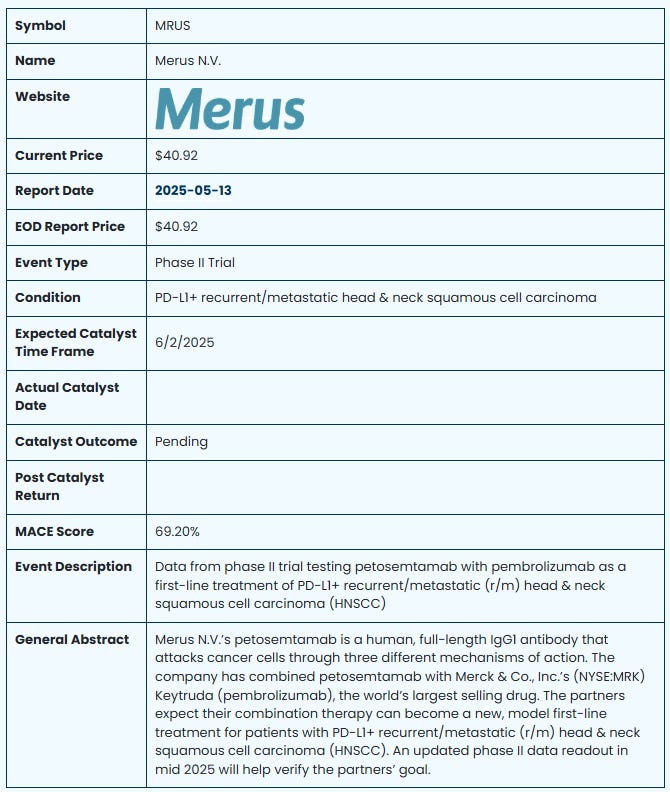Data from Merus N.V.’s (MRUS) petosemtamab may be game changer in Head & Neck cancer
Assigning a 69.2% overall probability updated data from Merus will be significantly positive.
Merck & Co., Inc.’s (NYSE:MRK) Keytruda (pembrolizumab) became the world’s top-selling drug in 2023 and last year’s $29.5 billion in revenue once again secured first place. Merck aggressively expanded the cancer indications for pembrolizumab over the years and broadly collaborated to treat cancer patients where pembrolizumab and chemotherapy fell short.
For example, in head & neck squamous cell carcinoma (HNSCC) pembrolizumab as a monotherapy demonstrated overall response rates (ORRs) between 18% and 21%. When chemotherapy was added, the ORR increased to ~35%. In another trial, pembrolizumab plus a molecule to activate antigen-presenting cells yielded an ORR of 29.7%.
Merus N.V.’s petosemtamab is a human, full-length IgG1 antibody that targets the epidermal growth factor receptor (EGFR) and the leucine-rich repeat containing G-protein-coupled receptor 5 (LGR5). The result is three independent mechanisms of action, which work to complement the immunotherapeutic action of pembrolizumab. In December 2024, Merus reported interim clinical data, as of July 5, 2024, from a phase I/II trial of petosemtamab in HNSCC. The confirmed ORR from 75 evaluable patients was 36%. Merus plans to update the data at the ASCO meeting in June 2025. We assign a 69.2% overall probability the updated data from Merus will be significantly positive.
Key catalysts
Data from phase II trial testing petosemtamab with pembrolizumab as a first-line treatment of PD-L1+ recurrent/metastatic (r/m) head & neck squamous cell carcinoma (HNSCC)
Key catalyst dates
June 2, 2025 (abstract released May 22, 2025)
Overall Probability: 69.2%
Market Demand: 70.8%
Adoption by KOLs: 66.7%
Clinical Trial Progress: 76.7%
Experience & Capital: 60.0%

The December 2024 data was even more impressive in 24 evaluable patients who received the petosemtamab-pembrolizumab combination as a treatment for first-line, PD-L1 positive HNSCC. In that cohort, the ORR was 67%. The abstract to be unveiled at ASCO will update the interim 24-patient data in December and include the entire 45-patient data set.
While the checkpoint activity of the PD-L1 pembrolizumab is well understood, Merus’s “multiclonics” platform designed petosemtamab to include inhibition of EGFR-dependent signaling, LGR5 binding leading to EGFR internalization and degradation in cancer cells, and enhanced antibody-dependent cell-mediated cytotoxicity (ADCC) and antibody-dependent cellular phagocytosis (ADCP) activity. (Quite a mouthful of activity!) The multiple mechanisms of action, however, appear to successfully clean up many toxic pathways and cells as Merus’ track record of collaborations demonstrates its platform works.
In addition to its work with pembrolizumab, Merus owns collaborations with Eli Lilly & Company (NYSE:LLY) and Gilead Sciences, Inc. (NASDAQ:GILD), among others. Moreover, Merus secured approval of Bizengri (zenocutuzumab-zbco) to treat adults with pancreatic adenocarcinoma or non–small cell lung cancer (NSCLC) who harbor a neuregulin 1 (NRG1) gene fusion.
THE EDGE
Merus is applying oncology precision medicine to the nth degree. The combination of petosemtamab and pembrolizumab as a first line HNCCC treatment could be a breakthrough event for the company. Not surprisingly, the FDA awarded breakthrough therapy designations for petosemtamab in two indications. First in recurrent/metastatic (r/m) HNSCC and solid tumors. Then again, for PD-L1 positive r/m HNSCC.
Merus has started a phase III trial for the petosemtamab and pembrolizumab combination in PD-L1 positive r/m HNSCC. The trial aims to enroll 500 patients. If patients had previous treatments with anti PD-(L)1 or anti-EGFR therapies, enrollment is not allowed.
The phase II update in the next few weeks for the 45 patients receiving the petosemtamab and pembrolizumab combination will validate the initiation of the phase III trial. Remember the FDA awarded a second breakthrough therapy designation for the combination therapy for PD-L1 positive r/m HNSCC. PD-L1 expression, or PD-L1 positive, reflects the proportion of tumor cells expressing PD-L1. Pembrolizumab typically is not administered unless the PD-L1 expression level is 50% or higher. As an HNSCC monotherapy, pembrolizumab demonstrated ORRs between 18% and 21%. When petosemtamab was added the figure jumped to 67% in HNSCC, after 24 patients.
While the 67% ORR after 24 patients may not be sustained, the likelihood of an ORR higher than 50% appears high and should provide sufficient momentum for Merus and investors.
Disclosures:
Initiating coverage and a position in MRUS, and may close position prior to or following the expected catalyst date.




